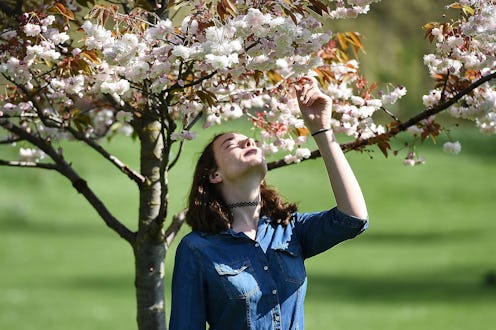Wellness
If Your Mood Changes When It Gets Warmer, It Could Be A Kind Of Seasonal Depression

Many people are familiar with seasonal affective disorder, or SAD, as a form of depression that comes to the surface during the winter. SAD is traditionally liked to seasonal changes like lower light levels (hello, Daylight Savings), cooler temperatures, and lifestyle changes. But there's another kind of seasonal affective disorder that hits when the weather gets nicer. Reverse SAD is a condition that affects your mood as the temperatures get warmer, and though it's less common than its chillier cousin, it also can change your mood in unexpected ways.
Just like SAD that's associated with winter, SAD that occurs in spring or summer occurs at roughly the same time each year, coinciding with the seasons, Dr. Marc Romano M.D., director of medical services at Delphi Behavioral Health, tells Bustle. Even though there's (theoretically) more light out in the spring, which is usually a go-to treatment for SAD, a small proportion of people with SAD deal with mood changes in the warmer months. "About 10% of people with seasonal depression experience it during the summer" Dr. Seema Sarin M.D., director of lifestyle medicine at health provider EHE Health, tells Bustle. "The National Institutes of Health (NIH) reports that people with reverse SAD could experience symptoms up to 40% of each year," Dr. Sarin says.
What Are Reverse Seasonal Affective Disorder's Symptoms?
"While Winter SAD presents with increased appetite, hypersomnia, and low energy, Summer SAD is the opposite and consists of decreased appetite, insomnia, and increased energy," Dr. Romano tells Bustle. Dr. Sarin says that anxiety can be one of the symptoms of reverse SAD too. The condition may resemble hypomania, the milder form of mania that accompanies bipolar disorder II. Having too much energy and not enough sleep may sound great for productivity and socializing in the summer months, but aren't actually very good for your overall health.
What Causes Summertime Seasonal Affective Disorder?
"Various studies have attempted to explain Summer SAD and have proposed such causes as high pollen counts, exposure to too much sunlight, high temperatures, and changes in circadian rhythms," Dr. Romano tells Bustle. "Researchers don't know the causes of reverse SAD, but they theorize that, like winter SAD, feelings of depression may be linked to the amount of light people receive," Dr. Sarin says. Changes in melatonin production, the hormone that regulates human sleep and is stimulated by exposure to sunlight, have been suggested as a serious candidate for what's behind the mood change. "In warmer climates close to the equator, reverse SAD is more common than it is in temperate zones," Dr. Sarin says. Melatonin changes can mess with your energy levels and sleep — it's marketed as a sleep aid for people with jet lag — but more research needs to be done on whether it might affect reverse SAD.
An interesting study published in Current Biology in 2015 reveals something that may contribute to reverse SAD: the season in which you were born. According to tests on mice, those who were born in summer were more likely to respond well to warm temperatures in their adult lives, while those born in winter appeared to be less positive about them. There's no research yet to indicate that this is the case in humans, but it could be an additional factor.
How Do You Manage Reverse Seasonal Affective Disorder?
If you believe you're dealing with reverse SAD, you can seek out help. "Treatment can be seasonal, just like the condition," Dr. Sarin says. "Keeping up a healthy exercise schedule, continuing to eat healthy food, and limiting the daily hours of sun you experience can help to relieve the symptoms of reverse seasonal affective disorder." The National Alliance on Mental Illness says that not everybody with SAD needs treatment all year round. Dr. Romano adds that antidepressant medication and an improved sleep-wake cycle have been proposed as treatments too, as has talk therapy.
Experts:
Dr. Marc Romano M.D.
Dr. Seema Sarin M.D.
Studies cited:
Green, N. H., Jackson, C. R., Iwamoto, H., Tackenberg, M. C., & McMahon, D. G. (2015). Photoperiod programs dorsal raphe serotonergic neurons and affective behaviors. Current biology : CB, 25(10), 1389–1394. https://doi.org/10.1016/j.cub.2015.03.050
Melrose S. (2015). Seasonal Affective Disorder: An Overview of Assessment and Treatment Approaches. Depression research and treatment, 2015, 178564. https://doi.org/10.1155/2015/178564
This article was originally published on